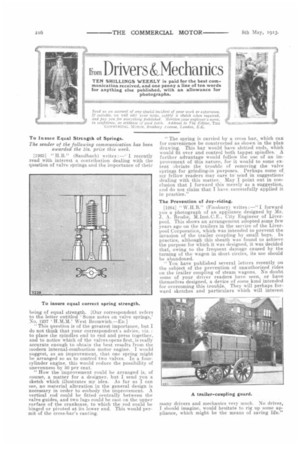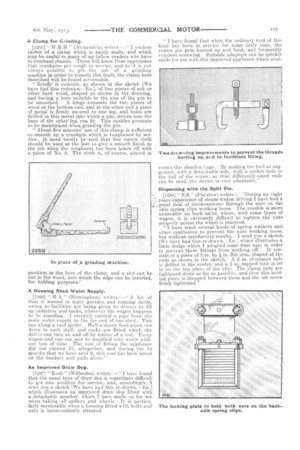horn Drivers &Mechanics
Page 24

Page 25

If you've noticed an error in this article please click here to report it so we can fix it.
TEN SHILLINGS WEEKLY is paid for the best com. Inunication received, and one penny a line of ten words for anything else published, with an allowance for photographs.
Send us an account of any sPecial incident of your work or experience. If suitable, we will edit your VOECS, sufiPly a sketch when required, and pay you for everything published. Mention your employer's name, in confidence, as evidence of good faith, Address to The Editor, THE
Commr.RcTAL MOTOR, Rosebery Avenue, London, E.G.
To Instil e Equal Strength of Springs.
The sender of the following communication has been awarded the .10s. prize this week.
[1263] "H.B." (Sandbach) writes :—" I recently read with interest a contribution dealing with the question of valve springs and the importance of their being of equal strength. [Our correspondent refers to the letter entitled ' Some notes on valve springs,' No. 1237 West Bromwich.—En.]
"This question is of the greatest importance, but I do not think that your correspondent's advice, viz. : to place the spindles end to end and press together, and to notice which of the valves opens first, is really accurate enough to obtain the best results from the modern internal-combustion motor engine. I would suggest, as an improvement, that one spring might be arranged so as to control two valves. In a fourcylinder engine, this would reduce the possibility of unevenness by 50 per cent.
"How the improvement could be arranged is, of course, a matter for a designer, but I send you a sketch which illustrates my idea. As far as I can see, no material alteration in the general design is necessary in order to embody the improvementA vertical rod • could be fitted centrally between the valve guides, and two lugs could be cast on the upper surface of the crankcase, to which the rod could be hinged or pivoted at its lower end. This would permit of the cross-bar's canting. " The spring is carried by a cross bar, which can for convenience be constructed as shown in the plan drawing. This bar would have slotted ends, which would fit over and control both tappet spindles.. A further advantage would follow the use of an improvement of this nature, for it would to some extent obviate the trouble of removing the valve springs for grinding-in purposes. , Perhaps some of, my fellow readers may care to-send in suggestions' dealing with this matter. May I point out in conclusion that I forward this merely as a suggestion, and do not claim that I have successfully applied it in practice."
The Prevention of Joy-riding.
[1264] " W.H.B." (Finsbury) writes :—" I forward you a photograph of an appliance designed by Mr. J. A. Brodie, M.Inst.C.E., City Engineer of Liverpool. This shows an arrangement adopted some few years ago on the trailers in the service of the Liverpool Corporation, which was intended to prevent the invasion of the trailer coupling by small boys. In practice, although this sheath was found to achieve the purpose for which it was designed, it was decided that, owing to the frequent damage caused by the turning of the, wagon in short circles, its use should be abandoned. " You have published several letters recently on the subject of the prevention of unauthorized rides on the trailer coupling of steam wagons. No doubt some of your driver readers have seen, or have themselves designed, a device of giome kind intended or overcoming this trouble. They will perhaps forward sketches and particulars which will interest A Clamp for Grinding.
[1266] " W.E.II." (Alexandria) writes :—" I enclose sketch of a clamp which is easily made, and which may be useful to many of my fellow readers who have to overhaul chassis. These will know from experience that crankpins get rough in service, and as it is not always possible to get the use of a grinding machine in order to remedy this fault, the clamp here described will be found serviceable.
"Briefly it consists, as shown in the sketch [We have had this redrawn.—Enl, of two pieces of ash or other hard wood, shaped as shown in the drawing, and having a bore suitable to the size of the pin to be smoothed. A hinge connects the two pieces of wood at the bottom end, and at the other end a piece of metal is firmly secured to one leg, and holes are drilled in this metal into which a pin, driven into the base of the other leg, can fit. This enables pressure to be maintained when grinding the pin.
"About five minutes' use of this clamp is sufficient to smooth up a crankpin which is roughened by service. It need hardly be said that fine emery cloth should be used at the last. to give a smooth finish to the job when the roughness has been taken off with a, piece of No. 2. The cloth is, of course, placed in
position in the bore of the clamp, and a slot can be cut in the wood, into which the edge can be inserted, for holding purposes."
A Running Shed. Water Supply.
[1266] "HA." (Birmingham) writes :—" A lot of time is wasted in many garages and running sheds, owing to facilities not being given to drivers to fill up radiators and tanks, wherever the wagon happens to be standing. I recently carried a pipe from the main water supply to the far end of our shed. This ran along a roof girder. Half-a-dozen feed-pipes run down to each stall, and cocks are fitted which the driver can turn on and off by means of a rod.Every wagon and van can now be supplied with water without loss of time. The cost of fitting the ap'plianer did not exceed. £1, altogether, and during the 12 months that we have used it, this cost. has been saved on the buckets and pails alone."
An Improved Draw Dog.
[1267] " Kosh " (Willesden) writes :—" I have found that the usual type of draw dog is sometimes difficult to get into position for service, and, accordingly, I send you a sketch [We have had this re-drawn.—ED.] which illustrates an improved draw dog fitted with a detachable member, which I have made up for use when taking off pulleys and wheels. It is particularly serviceable when a housing fitted with bolts and nuts is inconveniently situated. "I have found that when the ordinary tool of this kind has been in service for some little time, the centre pin gets burred up and bent, and frequently requires renewing. Suitable adapters can be quickly made for use with this improved appliance which over
comes this disadva::tage. By making the tool as suggested, with a detachable side, with a socket hole in the tail of the screw, so that differently-sized ends can be used, the device is very adaptable."
Dispensing with the Split Pin.
[1.268J " E.S." (Plaistow) writes : -"During my eight years experience of steam-wagon driving I have had a great deal of inconvenience through the nuts on the axle spring clips working loose. The trouble is more noticeable on back axles, where, with some types of wagon, it is extremely difficult to tighten the nuts properly unless the wheel is removed. "I have tried several kinds of spring washers and other appliances to prevent the nuts working loose, but without satisfactory results. I send you a sketch [We have had this re-drawn.—En.] which illustrates a little dodge which I adopted some time ago, in order to prevent these fittings from working off. It consists of a piece of 2 in. by I in. flat iron, shaped at the ends as shown in the sketch. A in. clearance hole is drilled in the centre, and a in. tapped hole is let in on the top plate of the clip. The clamp nuts are tightened down as far as possible, and then this holding piece is dropped between them and the set screw firmly tightened."


























